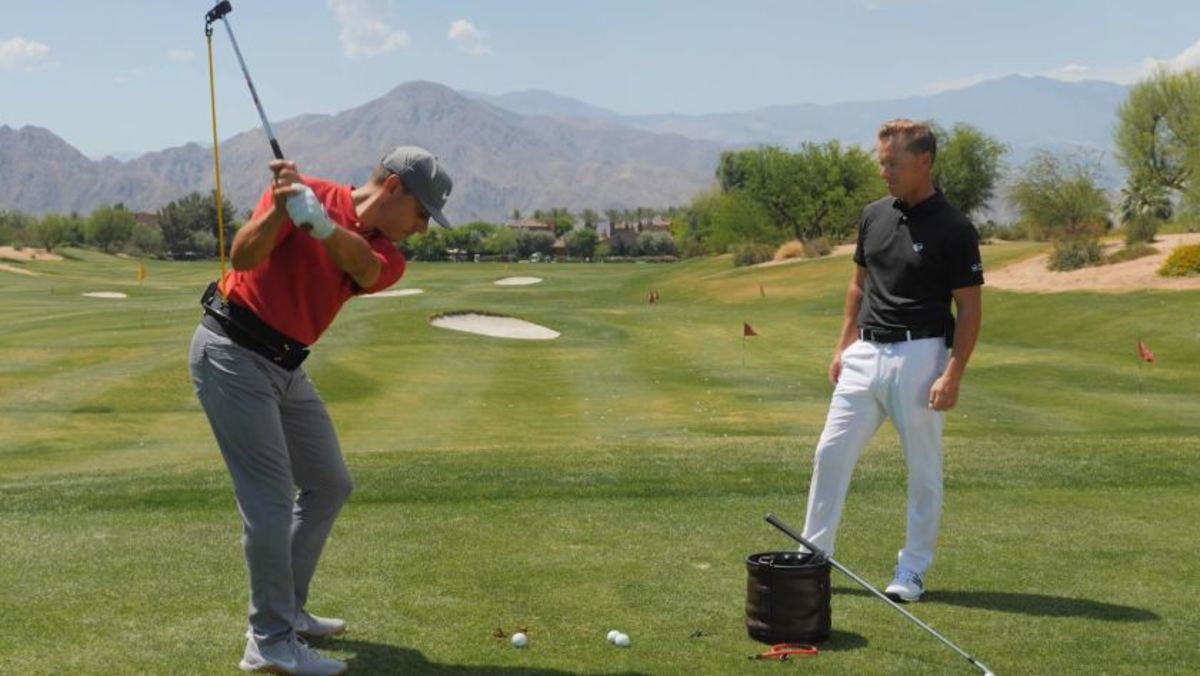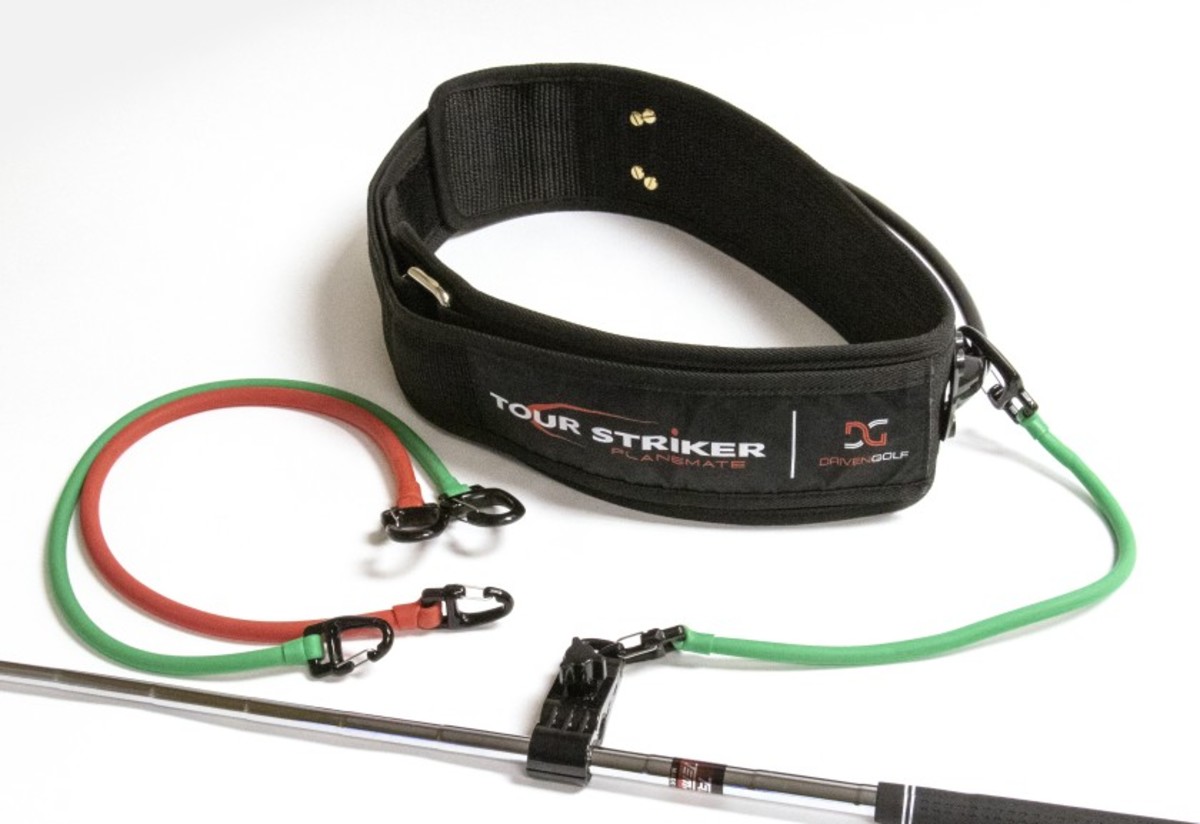PlaneMate: Cures an amateur’s slice, impresses world No. 1

Does your golf game suffer from an all-too-common slice?
Tired of having to align shots 30 to 50 yards off line just to land your tee shot in the fairway? Have you been told that the problem stems from an over-the-top motion during the swing but you just don’t know how to fix it?
Well, what if there was an aid that could eliminate your slice and correct that transitional mistake in your swing, and it would cost just $162.99?
All of that sounds like a cheesy, too-good-to-be-true infomercial — the kind that monopolizes commercial breaks during late-night rebroadcasts of tournaments on the Golf Channel. And you’re right. Read out loud in an overly enthusiastic tone, those questions easily become a gimmicky sales pitch. There’s just one catch: the message is true.
That’s the allure of Tour Striker’s PlaneMate, a wearable training aid created by PGA of America instructors Martin Chuck and David Woods. It allows players to take full swings and, through the use of resistance bands, to learn and feel how they should be positioned during all moments of the backswing, downswing, and follow-through. As the product’s name implies, the training aid is designed to keep players on plane through every phase of the golf swing.
“Most of the golfers that we’ve been coaching for 30 years, they have a delivery where they zip it inside, they get over the top, the club gets steep and it’s always a reaction from there,” Chuck said. “They’re always fitting in their game around the course. They’re not really hitting it crisply or efficiently.”
The PlaneMate is worn like a belt with a tension band that connects about a third of the way up a golf club’s shaft. The device emphasizes three key principles — think of them as the three Rs: resist, relax and rotate. The resistance occurs mostly during the backswing, at which point players must maintain a feeling of tension through the band during the takeaway, all the way to the peak of the backswing. From there, the PlaneMate teaches players how to relax their arms and wrists — alleviating that tension — which starts the downswing on a shallower plane. Finally, players are guided through the proper rotation, which promotes an inside-out strike of the ball.

“Most golfers don’t have near enough tension going back to relax properly [at the top of the backswing],” Chuck said. “They go back kind of soft and sloppy and then they have nothing really to unwind and let shallow to speed it up into the golf ball.”
In the simplest of terms, the PlaneMate, according to Chuck, helps golfers to understand “how to keep tension in the right places, and how to relax in the right place.”
The Tour Striker aid isn’t relegated only to struggling duffers and high-handicappers desperate to improve. Much like the brand’s Smart Ball, which Justin Rose was seen using in 2017 when he was world’s No. 1 golfer, the PlaneMate was recently tested by Rory McIlroy, who at the time of this writing sat atop the official world golf rankings, himself.
Videos of the Northern Irishman wearing the PlaneMate and hitting wedge shots at The Bears Club circulated across social media platforms in early October. Two weeks later at a skins match in Japan, McIlroy was filmed on the first tee before the match started, talking up the unique feelings of tension that the training aid imparts and suggesting that it’s a good training device for learning to use and strengthen core muscles during the downswing.
“Oh, that thing?” he said, when someone brought up the PlaneMate. “It’s ridiculous!”
The training aid isn’t just a slice-curer, however. It’s far more versatile than that. Tour professionals and amateurs with single-digit handicaps can also benefit from routine sessions with the PlaneMate, and that includes players who naturally hit a draw and whose miss isn’t a slice but a hook. As Chuck explains, “those players have been shallowing the club into a power position at the top of their backswing for most of their life, and they can overdo it. The club can get too far behind them, and then they can get stuck and they’ll hit blocks or hooks.”
The PlaneMate can address those mistakes, too. Instead of relaxing the tension from the band at the top of the backswing, those players must learn to maintain the tension. That will prevent the club from dropping too low and too far behind them on the downswing. “They’re so powerful, they need to create resistance on the way down,” Chuck says of those particular players. “Instead of relaxing, they stay wide and keep tension on the band and then they rotate like crazy [through the swing].”

The training aid includes three different resistance bands, two green ones that offer moderate resistance — one designed for full swings and the other for pitch shots — and a red band that introduces ample residence and is intended for stretching and strengthening exercises, rather than actual swings.
Although the PlaneMate may look intimidating to prospective users, Chuck assures that golfers can use it successfully on their own. To that end, he and Woods created a seven-day series of videos that guides golfers through their use of the device, first breaking down the golf swing into key segments and addressing how a player’s body should be positioned and what feelings they should focus on —through the body and the amount of tension felt through the resistance band.
The protocol begins with half-swings to ingrain the fundamentals and then graduates to bigger swings, where the two instructors explain that the device provides “muscular awareness of how to get the club a little more vertical in the backswing.”
As Chuck explains at the end of the seventh video tutorial, “It’s the beginning of you learning how to shape your swing, to get that consistency and reliability that you want to get the club head to the ball to hit your best shots.”
The PlaneMate doesn’t have to be used as a traditional training aid, either. It can be used just to reinforce proper positioning without the golfer hitting shots. It can also be used at home as a stretching aid.
But when used as a traditional training aid, the PlaneMate’s impact can be significant.
“It makes different muscles fire in different ways [compared to what most golfers are used to],” Chuck said. “When your muscles are doing the work and you have frame of reference, the body feels differently. Your brain is connecting to that way better than it connects to a teacher who just puts you into position.”
Sign up to receive the Morning Read newsletter, along with Where To Golf Next and The Equipment Insider.
